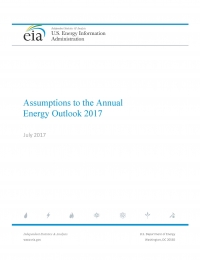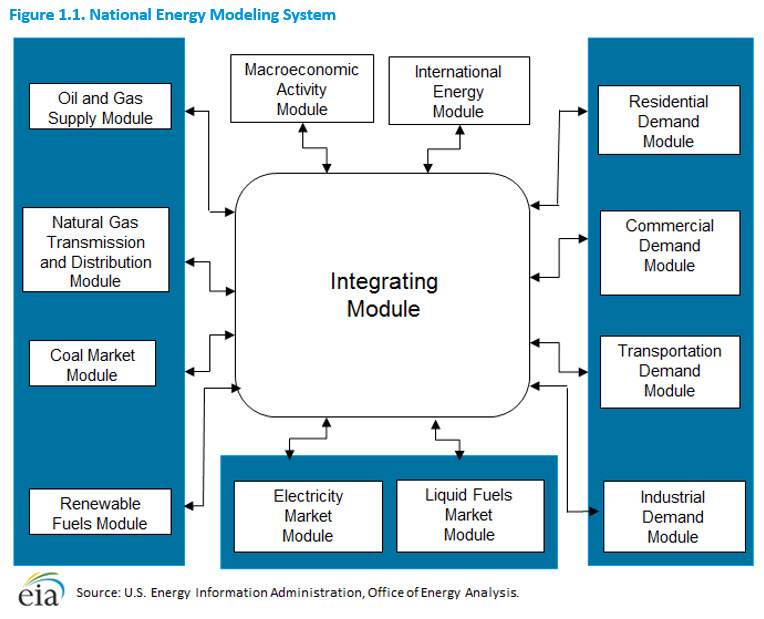EIA: Assumptions to the Annual Energy Outlook 2017 - eng (pdf) Избранное
This report presents the major assumptions of the National Energy Modeling System (NEMS) used to generate the projections in the Annual Energy Outlook 2017 [1.1] (AEO2017), including general features of the model structure, assumptions concerning energy markets, and the key input data and parameters that are the most significant in formulating the model results. The AEO is now on a biennial schedule with a full report every other year. AEO2017 is an abridged report and contains fewer side cases than the prior AEO. Detailed documentation of the modeling system is available in a series of documentation reports [1.2]. Important changes since the most recent documentation will be featured in this report and as such no additional formal documentation will be provided until the next long report in AEO2018.
The National Energy Modeling System
Projections in AEO2017 are generated using NEMS [1.3], developed and maintained by the Office of Energy Analysis of the U.S. Energy Information Administration (EIA). In addition to its use in developing the Annual Energy Outlook (AEO) projections, NEMS is used to complete analytical studies for the U.S. Congress, the Executive Office of the President, other offices within the U.S. Department of Energy (DOE), and other federal agencies. NEMS is also used by nongovernmental groups, such as the Electric Power Research Institute, Duke University, and the Georgia Institute of Technology. In addition, AEO projections are used by analysts and planners in other government agencies and nongovernmental organizations.
The projections in NEMS are developed with the use of a market-based approach, subject to regulations and standards. For each fuel and consuming sector, NEMS balances energy supply and demand, accounting for economic competition across the various energy fuels and sources. The time horizon of NEMS currently extends to 2050. To represent regional differences in energy markets, the component modules of NEMS function at the regional level: the 9 Census divisions for the end-use demand modules; production regions specific to oil, natural gas, and coal supply and distribution; 22 regions and subregions of the North American Electric Reliability Corporation for electricity; and 9 refining regions within the 5 Petroleum Administration for Defense Districts (PADDs). Complete regional and detailed results are available on the EIA Analysis and Projections Home Page (www.eia.gov/analysis/).
NEMS is organized and implemented as a modular system (Figure 1.1). The modules represent each of the fuel supply markets, conversion sectors, and end-use consumption sectors of the energy system. The modular design also permits the use of the methodology and level of detail most appropriate for each energy sector. NEMS executes each of the component modules to solve for prices of energy delivered to end users and the quantities consumed, by product, region, and sector. The delivered fuel prices encompass all activities necessary to produce, import, and transport fuels to end users. The information flows also include such areas as economic activity, domestic production, and international petroleum supply. NEMS calls each supply, conversion, and end-use demand module in sequence until the delivered prices of energy and the quantities demanded have converged within tolerance, thereby achieving an economic equilibrium of supply and demand in the consuming sectors. A solution is reached for each year from 2017 through 2050. Other variables, such as petroleum product imports, crude oil imports, and several macroeconomic indicators, are also evaluated for convergence.
Each NEMS component represents the effects and costs of legislation and environmental regulations that affect that sector. NEMS accounts for all combustion-related carbon dioxide (CO2) emissions, as well as emissions of sulfur dioxide (SO2), nitrogen oxides (NOX), and mercury from the electricity generation sector.
The integrating module of NEMS controls the execution of each of the component modules. To facilitate modularity, the components do not pass information to each other directly but communicate through a central data storage location. This modular design provides the capability to execute modules individually, thus allowing decentralized development of the system and independent analysis and testing of individual modules that appropriately reflect each energy sector.
The version of NEMS used for AEO2017 generally represents current legislation and environmental regulations, including recent government actions for which implementing regulations were available as of the end of September 2016. The potential effects of proposed federal and state legislation, regulations, or standards—or of sections of legislation that have been enacted but require funds and implementing regulations that have not been provided or specified—are not reflected in NEMS. The U.S. Environmental Protection Agency's (EPA) Clean Power Plan (CPP), is included in the Reference case of AEO2017. However, because of the continuing uncertainty surrounding its implementation, a No CPP case is also included. A list of the specific federal and selected state legislation and regulations included in the AEO, including how they are incorporated, is provided in Appendix A of this document.
Дополнительная информация
- Серия: Госорганы / Зарубежные / EIA / Annual Energy Outlook
- Год: 2017
- Источник: EIA
- EIA: Assumptions to the Annual Energy Outlook 2017 - eng (pdf) (1057 Скачиваний)



































